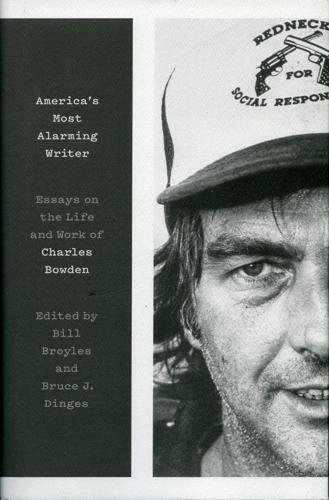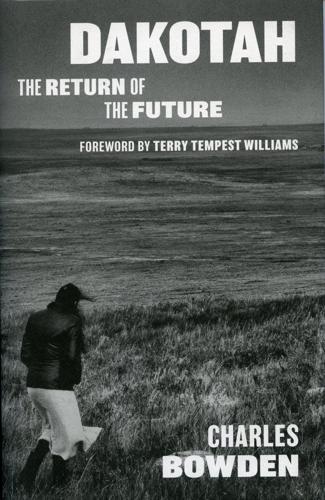University of Texas Press plans to publish a complete library of the late iconic author and chronicler of the Southwest, Charles Bowden. This edition of Southern √ŘŤ÷÷Ī≤• Authors focuses on a recently released tribute to Bowden and one of his previously unpublished works.
‚ÄúAmerica‚Äôs Most Alarming Writer: Essays on the Life and Work of Charles Bowden‚ÄĚ Edited by Bill Broyles and Bruce Dinges.
University of Texas Press. $29.95 print and Kindle.
Charles Bowden inspired his friends and colleagues in many ways. To poet and novelist Leslie Marmon Silko, Bowden was ‚ÄúCB,‚ÄĚ a man who ‚Äúembraced Santa Muerta‚ÄĚ and ‚Äúlived in defiance of borders;‚ÄĚ to √ŘŤ÷÷Ī≤• environmental reporter Tony Davis he was the ‚ÄúJimi Hendrix of journalists‚ÄĚ; former Pima County Supervisor Ray Carroll called Bowden ‚Äúa thorn in the side of injustice,‚ÄĚ and the late author Jim Harrison, whose Patagonia home Bowden used as a refuge, believed he was ‚ÄúAmerica‚Äôs most alarming writer.‚ÄĚ Bowden‚Äôs impact, both on Southwest letters and on the national conversation about the borderlands, is clearly evident in this collection of 50 essays, written by key figures in his life and compiled by the book‚Äôs editors as a literary homage to a writer with a uniquely America vision.
People are also reading…
Bowden gained national fame for his hard-hitting journalism about the Southwest, a landscape that he loved as much as he despised the forces that threaten to undermine it. With a distinctive voice and unblinking honesty, Bowden wrote with passion and urgency about the natural world, urban sprawl, greed, brutality, and politics.
‚ÄúI ‚Ķ believe with every bit of my being,‚ÄĚ he said in Credo, a talk he presented at the Pima County Public Library, ‚Äúthat the future is going to be a collision between limited resources and unlimited human appetites.‚ÄĚ
A vivid stylist with a reputation for disdaining convention and the status quo, Bowden began his award-winning journalism career as a reporter for the √ŘŤ÷÷Ī≤• Citizen, where his coverage of sexual abuse and border crossing made him a finalist for a Pulitzer Prize. He went on to launch √ŘŤ÷÷Ī≤•‚Äôs short-lived but highly regarded City Magazine and was a frequent contributor to national publications such as Esquire, GQ, National Geographic, Harper‚Äôs and Mother Jones, assignments he accepted because they paid the bills and allowed him to concentrate on writing books.
When not off on assignment, Bowden was at home in √ŘŤ÷÷Ī≤•. He wrote obsessively, rising at 3 a.m. to head to his ‚Äúwriting shack‚ÄĚ with a cup of coffee, emerging late in the afternoon to drink red wine and hold court with visitors. When he passed away in 2014, Bowden had published more than two dozen books, including ‚ÄúKilling the Hidden Waters,‚ÄĚ ‚ÄúFrog Mountain Blues‚ÄĚ and ‚ÄúDown by the River: Drugs, Money, Murder and Family.‚ÄĚ His literary legacy continues to inform the way we think about the desert‚Äôs fragile environment and borderland violence.
These 50 essays by Bowden‚Äôs friends, colleagues, and fellow desert rats make for thought-provoking and lively reading, as well as providing insights into the career of a consequential American writer. But ‚ÄúAmerica‚Äôs Most Alarming Writer‚ÄĚ is not simply a recounting of shared incidents in an eventful life, nor is it just an assessment of a remarkable body of work. Importantly, it is a revealing document about a fiercely driven investigative journalist‚Äôs relentless pursuit of the truth in the face of a society too willing to look the other way.
The collection is the brainchild of editors Bill Broyles and Bruce Dinges, longtime friends of Bowden‚Äôs and themselves prominent figures on the Southwest literary scene. Broyles has authored several books including ‚ÄúAmong Unknown Tribes,‚ÄĚ ‚ÄúDesert Duty‚ÄĚ and ‚ÄúSunshot‚ÄĚ and is a research associate at the University of √ŘŤ÷÷Ī≤•‚Äôs Southwest Center.
Dinges, the retired director of publications and the editor of the √ŘŤ÷÷Ī≤• Historical Society‚Äôs Journal of √ŘŤ÷÷Ī≤• History, has authored numerous articles and edited several books on Southwest history. They were well-positioned to reach out to contributors for chapters to the book. ‚ÄúSure, I‚Äôll do it for Chuck,‚ÄĚ was the response they heard most often.
The list of contributors reads like a ‚Äúwho‚Äôs who‚ÄĚ of notable authors and includes Luis Alberto Urrea, Richard Grant, William DuBuys and Philip Caputo. Jim Harrison whose ‚Äúalarming writer‚ÄĚ characterization inspired the book‚Äôs title, also compared reading Bowden to riding in a Ferrari without brakes. ‚ÄúThere‚Äôs lots of oxygen,‚ÄĚ he observed, ‚Äúbut no safe way to stop.‚ÄĚ
A number of familiar √ŘŤ÷÷Ī≤• names also grace the contributors list ‚ÄĒ from Gary Paul Nabhan and Katie Lee to Tom Sheridan and Francisco Cantu, to name just a few ‚ÄĒ and their essays will have special resonance for readers in the Old Pueblo. The book‚Äôs concluding essay is by Bowden himself, from a letter dated 2013‚ÄĒand it seems fitting that he gets to have the last word.
When he passed away, Bowden left behind several unpublished manuscripts, including ‚ÄúThe Red Caddy: Into the Unknown with Edward Abbey‚ÄĚ (2018) and the recently released ‚ÄúDakotah: The Return of the Future,‚ÄĚ the fourth volume in the author‚Äôs ‚ÄúUnnatural History of America‚ÄĚ sextet. Both of these titles have been published by the University of Texas Press, which will be bringing out more original works by Bowden as well as reprints of previous works.
‚ÄĒ Helene Woodhams
‚ÄúDakotah: The Return of the Future‚ÄĚ by Charles Bowden, with foreword by Terry Tempest Williams
University of Texas Press. $24.95.
‚ÄúI was born to be erased,‚ÄĚ writes Charles Bowden in the first chapter of this posthumous memoir. ‚ÄúAnd accept the fact.‚ÄĚ
‚ÄúDakotah,‚ÄĚ the fourth installment of Bowden‚Äôs ‚ÄúUnnatural History of America‚ÄĚ series (following ‚ÄúBlood Orchid,‚ÄĚ ‚ÄúBlues for Cannibals‚ÄĚ and ‚ÄúSome of the Dead Are Still Breathing‚ÄĚ), is a collage of personal memory and impressions, fragments of family history, surveys of prehistoric geological and human migratory movement, accounts of racist violence, vignettes of famous and infamous historic characters, and records of the struggles of and depredations by settlers in the American heartland. That‚Äôs not an unambitious 169 pages.
In her foreword, essayist Terry Tempest Williams suggests that ‚ÄúDakotah‚ÄĚ might be an unfinished manuscript. She says it‚Äôs written in ‚Äúshorthand; a prairie haiku.‚ÄĚ But it‚Äôs a rich haiku. It‚Äôs the conversation she says she would have had with Bowden: where did he come from? Who were his people? What kind of child was he? How did he come to ‚Äúunderstand the world as, at once, a place of tender beauty and injustices?‚ÄĚ She points out that this chronicler of violence and sex writes here that he is torn by two worlds ‚ÄĒ ‚Äúthe living one moving in the day and night through the grass and forest, cruising the rivers, coursing the seas. ‚Ķ And, the world of noise talking money ‚Ķ and patriotism ‚Ķ and hundreds of other lies.‚ÄĚ
Sparked by finally opening packets of love letters between his parents and fueled by a profound hunger to find ‚Äúplace,‚ÄĚ investigative journalist Bowden went on a search to investigate himself. Writing that he ‚Äúnever belonged,‚ÄĚ Bowden instead describes a place where he would belong ‚ÄĒ an ideal place, a piece of ground: ‚ÄúI will see it off to the side. I will know the feel of this place: the leaves stir softly on the trees, dry air smells like dust, birds dart and the trails are made by beasts living free. ‚Ķ I have never belonged to a place or movement or belief. But I still look. ‚Ķ I will see it.‚ÄĚ
His ‚Äúroots‚ÄĚ search took him to his family‚Äôs home ‚ÄĒ the Dakotas, Iowa, and Minnesota. He interviews family there, but also residents of ghosts of communities ‚ÄĒ towns settled in the last centuries that couldn‚Äôt survive the brutal weather, the endless winds, the ‚Äúdusters‚ÄĚ of the prairie. This book is about hope, disappointment, impermanence and erasure.
Bowden threads historic figures through the text. He follows Lewis and Clark as they encounter Sioux as they cross what is now North Dakota. He relates the erratic life story of Daniel Boone and corrects myths about Wild Bill Hickok and Calamity Jane (his dime-novel myth fared better for his early murder than hers, who resorted to Wild West shows and a ghost-written autobiography to stay in the public eye.) Bowden cites 20th century figures who needed to escape the heartland to make their ways in the world: Walt Disney, Peggy Lee, Laurence Welk, Frank L. Baum, who escaped the plains but immortalized it in ‚ÄúThe Wizard of Oz.‚ÄĚ
Central, though, are Bowden‚Äôs parents. As revealed in the letters, the courtship of Bowden‚Äôs father ‚ÄĒ a 41-year-old, educated city man who liked good suits and new cars ‚ÄĒ and Bowden‚Äôs mother ‚ÄĒ a 21-year-old, uneducated, small-town shop girl ‚ÄĒ is in part predicated on the dream of land: property to which they could escape. And they achieved it with an Illinois farm they called Rest Haven. There, on pungent grasses and in black dirt, among the chickens and pigs, beer-drinking men, and a dog named Dick, young Bowden came alive. When his father abruptly sold the land and moved the family to Chicago, Bowden was shattered. He writes as if seeking to reconnect with land was a constant in his life.
Bowden presents the natural world as a dearest companion (‚ÄúNo meeting of my kind has ever mattered to me,‚ÄĚ he writes, ‚Äúas much as a tree on a hillside in the grey light of dawn as the leaves go from black to green with the soft brushstrokes of the light.‚ÄĚ) There is no small measure of literary resonance in Bowden‚Äôs prose. While his expository style is clear Bowden journalistic, his descriptions of nature are lyrical and evocative. There‚Äôs a whiff of James Joyce in a child‚Äôs pre-verbal love for nature and the sensory impressions of a busy farm; a nod to Walt Whitman in a ‚Äúsong‚ÄĚ of the catalog of American things and people he feels part of.
Even though he denounces European invasion of America and describes the struggles of his family, you don‚Äôt see a sharp-edged Bowden in this book. Perhaps that‚Äôs due to the millennia-long view in which he sets his personal life. Perhaps it‚Äôs tempered by his child‚Äôs longing for nature. Perhaps it‚Äôs his acceptance that all life ‚ÄĒ grand or modest ‚ÄĒ was born to be erased. In any case, this is a meditation Bowden fans will not want to miss. To quote Terry Tempest Williams, it will make your ‚Äúheart hurt.‚ÄĚ
‚ÄĒ Christine Wald-Hopkins
Helene Woodhams retired from Pima County Public Library, where she was literary arts librarian and coordinator of Southwest Books of the Year, the library’s annual literature review.
Christine Wald-Hopkins is a former educator and occasional essayist. Wald-Hopkins has long been a book critic for national, regional and local newspapers.
If you are a Southern √ŘŤ÷÷Ī≤• author and would like your book to be considered for this column, send a copy to: Sara Brown, 4850 S. Park Ave., √ŘŤ÷÷Ī≤•, AZ 85714. Give the price and a contact name. Books must have been published within a year.

















